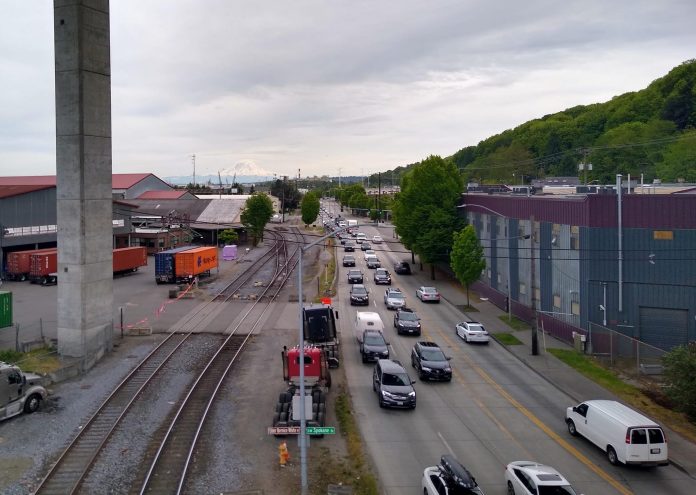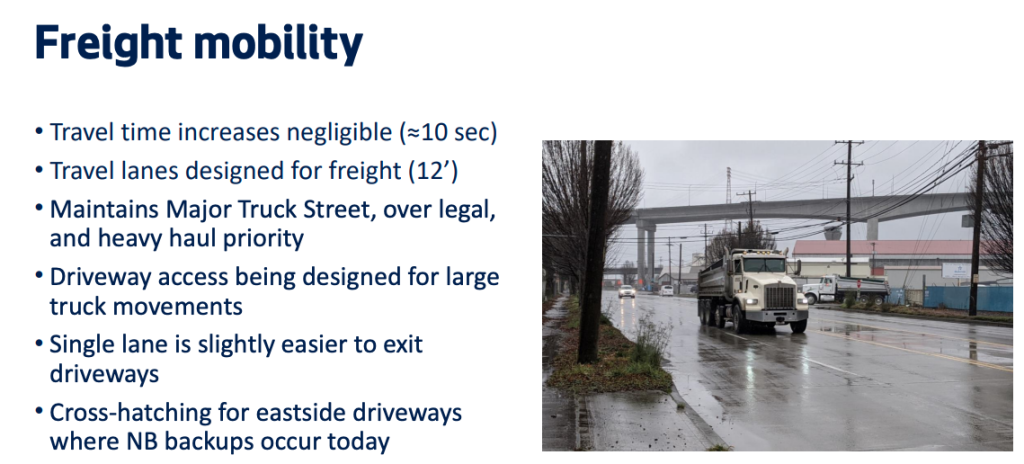Last Friday, the Seattle Department of Transportation (SDOT) held a closed-door meeting with members of the Bicycle and Freight Advisory Boards to discuss a planned protected bike lane that would finally connect the West Seattle Bridge Trail with the Duwamish Trail along West Marginal Way SW. The 0.4-mile connection is opposed by members of the Freight Advisory Board, who had been requesting a meeting with SDOT Director Sam Zimbabwe to discuss the project. It’s unclear if members of the Bicycle Advisory Board would have been invited to the meeting if The Urbanist had not reported on their April meeting. At that meeting, held without any agenda published beforehand, boardmembers discussed reasons that the bike lane should not be installed using a presentation that was created without SDOT’s involvement.
At Friday’s meeting, SDOT officially advocated for the bike facility via a presentation on the project’s benefits. SDOT’s Heather Marx, head of the West Seattle Bridge response, has told numerous groups (including the West Seattle Bridge Community Taskforce) that the project itself isn’t in jeopardy and that the decision expected any day now will involve whether the bike lane is installed this year (along with a new sidewalk and interim pedestrian signal on Marginal Way) or if the department will wait until after the West Seattle High Bridge reopens. The Freight Advisory Board is advocating that the project never be installed, and has written to the Durkan administration to request that the lane reduction SDOT has installed near the Duwamish Longhouse, in place since 2019, be removed as well as to return West Marginal to five full lanes on most of its length.
New details on the protected bike lane are revealed by the SDOT slides that The Urbanist has been able to obtain after the meeting. The biggest detail is that the current plan for West Marginal is to install a Jersey barrier along the entire length of the lane. Jersey barriers are not often used in bike lane projects in Seattle, but adding a bike facility to a freight corridor like Marginal calls for substantial protection.
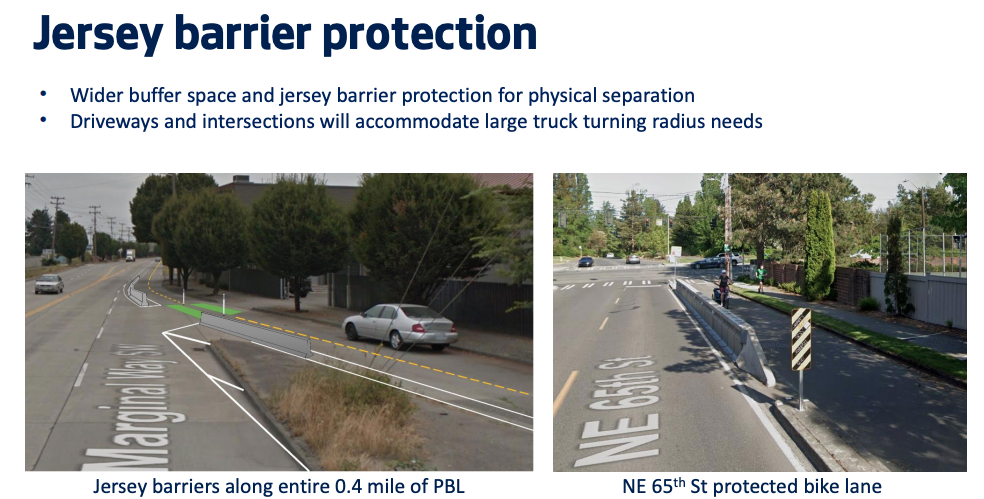
But the Freight Advisory Board’s concerns don’t appear to be assuaged after learning the actual planned lane widths. “Lanes on major truck streets less than the optimum 12’ for curbs and 11’ for all others results in large vehicles tracking out of lanes. Vehicle widths, mirror to mirror, are 10.5’ wide. Large trucks with trailers, turning, merging or traversing horizontal curves can track out of narrowed lanes resulting in vehicle sideswipes or crashes,” one of the slides from their competing presentation at Friday’s meeting read. “A protected bike lane could result in increasing vehicle conflicts by narrowing adjacent lanes and potentially impacting protected bike lanes.”
SDOT also presented a cross-section of the planned configuration for all lanes within the segment where the bike lane would go. The Freight Advisory Board has been concerned about lane widths, even presenting their own possible configuration that showed freight trucks in 10.5-foot lanes in both directions along Marginal. One 12-foot lane would be maintained in one direction, with the center turn lane and the remaining northbound lane becoming ten feet wide. With four feet for the buffer with the Jersey barrier in it, that leaves four feet for each direction in the bike lane, a tight squeeze but likely the best that could be accommodated given the constraints here.
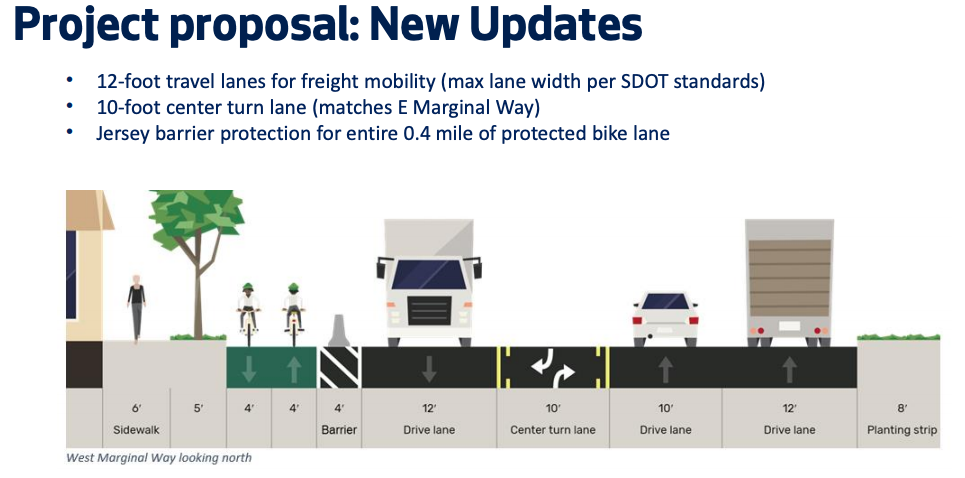
Former Mayor Greg Nickels, chair of the West Seattle Bridge Community Taskforce, has cited driveways used by businesses along the corridor as one reason the project needed further study. SDOT’s presentation notes that they are designing the lane to accommodate movements made by large trucks, and that it’s much easier to exit a driveway onto one lane of moving traffic rather than two. But freight advocates, including Port Commissioner Peter Steinbrueck, have continued to push the City to explore options that would place the trail extension on the sidewalk, which would be exponentially more expensive and involve the removal of street trees. It’s also not clear how that would be better for visibility.
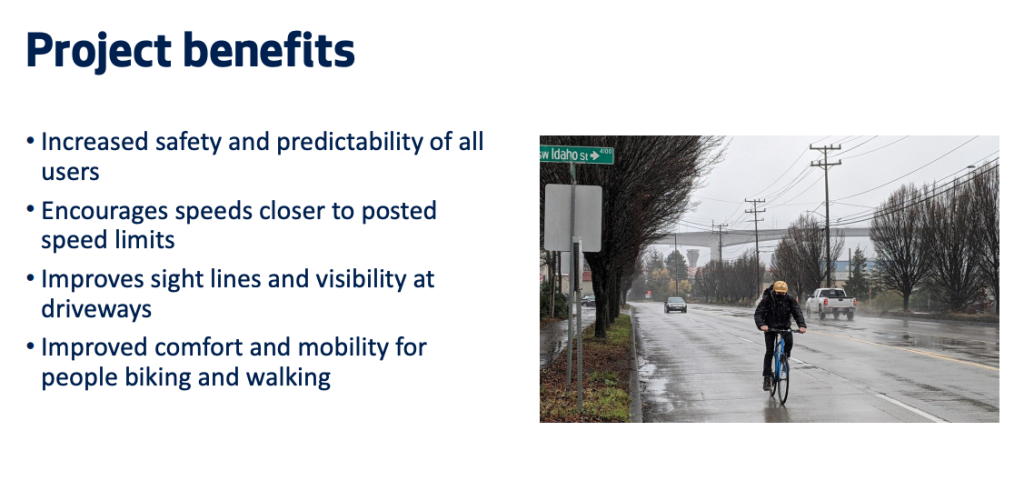
The Freight Advisory Board has also cited the improvements being made at Terminal 5 and the planned expansion of SR-509 (which connects with SR-99 at West Marginal Way) in South King County as reasons that capacity on West Marginal Way SW should not be reduced. But an SDOT presentation to that board earlier this year noted that the Terminal 5 improvements are only expected to add three additional southbound trucks to the facility compared to current traffic levels, a change of 0.3%. On Friday, the department again noted that the stretch of Marginal Way in question is not a bottleneck here; the five-way intersection at Chelan Ave SW is — and 80% of the vehicles going southbound are using the other southbound lane already. Using a highway expansion sucking up state highway funds as an excuse to not construct a segment of the dramatically underfunded Seattle Bicycle Master Plan is a nice touch, though.
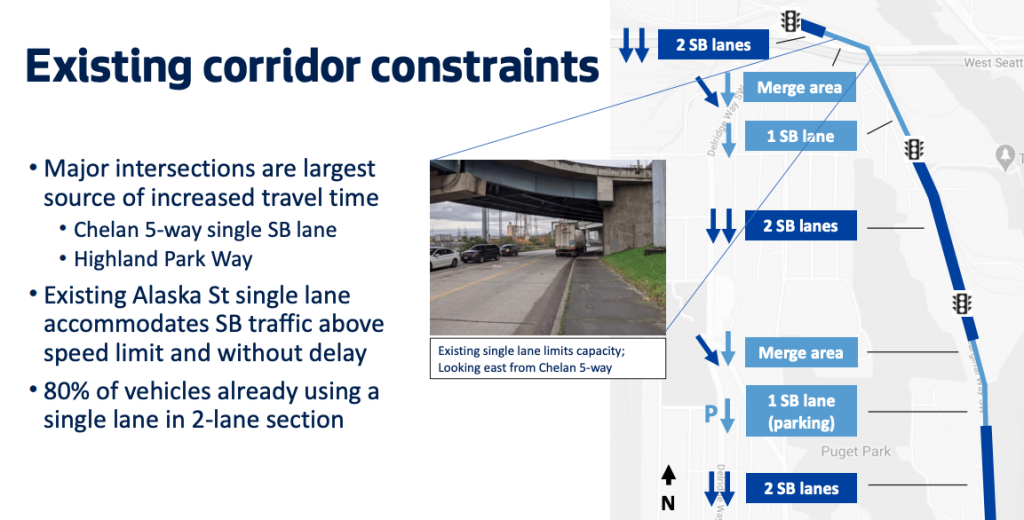
SDOT reiterated that it expects the impacts from adding this bike lane to amount to around ten seconds of delay. The argument hasn’t seemed to placate members of the Freight Advisory Board, who appear to view this project as more important symbolically as SDOT taking space in their domain: a major truck street.
According to several meeting attendees I spoke with, the meeting was positive, but it did not lead to a resolution between the parties, as most would expect. We also do not have a better idea of when SDOT intends to announce whether the project will move forward and if so, when. Every deadline for a decision has been pushed, likely due to the insistence of groups like the Freight Advisory Board for more process, but the latest update was that a decision would be made by the end of June.
A “compromise” to build the lane after the West Seattle High Bridge reopens doesn’t really address the concerns of the Freight Advisory Board and also doesn’t address the real safety concerns that people biking in the corridor currently have, but as 2021 progresses it appears to be increasingly likely. If that was the outcome, it remains unclear if that will be the end of pushback from the freight community on this proposal.
Ryan Packer has been writing for The Urbanist since 2015, and currently reports full-time as Contributing Editor. Their beats are transportation, land use, public space, traffic safety, and obscure community meetings. Packer has also reported for other regional outlets including BikePortland, Seattle Met, and PubliCola. They live in the Capitol Hill neighborhood of Seattle.

